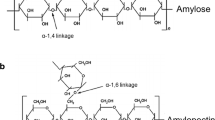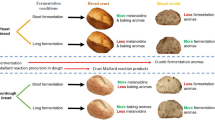Abstract
Various botanical and structural characteristics of starchy foods are considered to modify the rate of starch digestion and the glycaemic responses in humans. The main objective of the study was to examine the impact of fermented barley and oat microstructure on the rate of in vitro starch hydrolysis. A dynamic gastrointestinal model was used to estimate the degree of starch hydrolysis during in vitro digestion of fermented whole grain cereal meals. Light microscopy and confocal laser scanning microscopy were used to study the microstructural changes. In parallel to the in vitro studies, the impact of fermented barley and oats on postprandial plasma glucose responses was evaluated in a human study. Micrographs were taken during in vitro digestion experiments with fermented whole grains and compared with micrographs of boiled barley (undigested). Images showed that most of the oat starch granules were degraded after 120 min of digestion, whereas barley starch granules were less degraded, even after 180 min of digestion. The findings were confirmed by faster starch hydrolysis from the fermented oat meal, measured as maltose generated during in vitro digestion. The area under the curve (AUC) was calculated from the plotted maltose curves of the meals. AUC for barley tempe (266 ± 33) was 40 % of the AUC for oat tempe (663 ± 8) and significantly different (p < 0.007) from AUC oat tempe. The in vitro data closely resembled the AUCs for plasma glucose from the parallel human study. In terms of glucose response, the mean AUC for barley tempe was 46 % of the AUC for oat tempe in the human study. The agreement between the in vitro and in vivo data indicates the potential of the in vitro method as a tool to predict the rate of starch degradation of cereal products.










Similar content being viewed by others
References
Andersson JW, Baird P, Davis RH, Ferreri S, Knudtson M, Koraym A, Waters V, Williams CL (2009) Health benefit of dietary fibre. Nutr Rev 67(4):188–205
Barcaly A, Petocz P, McMillan-Price J, Flood M, Prvan T, Mitchell P, Brand-Miller JC (2008) Gycemic index, glycemic load, and chronic disease risk—a meta anlysis of obesrvational studies. Am J Clin Nutr 87:627–637
Behall KM, Scholfield DJ, Hallfrisch J (2004) Lipids significantly reduced by diets containing barley in moderately hypercholesterolemic men. J Am Coll Nutr 23:55–62
Liljeberg H, Björck I (1994) Bioavailability of starch in bread products—postprandial glucose and insulin responses in healthy-subjects and in-vitro resistant starch content. Eur J Clin Nutr 48:151–163
Fredriksson H, Silverio J, Andersson R, Eliasson AC, Aman P (1998) The influence of amylose and amylopectin characteristics on gelatinization and retrogradation properties of different starches. Carbohydr Polym 35:119–134
Behall KM, Hallfrisch J (2002) Plasma glucose and insulin reduction after consumption of breads varying in amylose content. Eur J Clin Nutr 56:913–920
Jenkins DJA, Kendall CWC, Augustin LSA, Franceschi S, Hamidi M, Marchie A et al (2002) Glycemic index: overview of implications in health and disease. Am J Clin Nutr 76:266S–273S
Östman E, Rossi E, Larsson H, Brighenti F, Björk I (2006) Glucose and insulin responses in healthy men to barley bread with different levels of (1→3;1→4)-β-glucans; predictions using fluidity measurements of in vitro enzyme digests. J Cereal Sci 43(2):230–235
Hallström E, Sestil F, Lafiandra D, Björk I, Östman E (2011) A novel wheat variety with elevated content of amylose increases resistant starch formation and may beneficially influence glycaemia in health subjects. Food Nutr Res 55:7074. doi:10.3402/fnr.v55i0.7074
Wong JMW, de Souza R, Kendall CWC, Emam A, Jenkins DJA (2006) Colonic health: fermentation and short chain fatty acids. J Clin Gastroenterol 40:235–243
Autio K, Salmenkallio-Marttila M (2001) Light microscopic investigations of cereal grains, doughs and breads. LWT - Food Sci Technol 34:18–22
Achi OK (2005) The potential for upgrading traditional fermented foods through biotechnology. Afr J Biotechnol 4:375–380
Hachmeister KA, Fung DYC (1993) Tempeh: a mold-modified indigenous fermented food made from soybeans and/or cereal grains. Crit Rev Microbiol 19(3):137–188
Östman EM, Elmståhl HGML, Björck IME (2002) Barley bread containing lactic acid improves glucose tolerance at a subsequent meal in healthy men and women. J Nutr 132:1173–1175
Alminger M, Eklund-Jonsson C (2008) Whole-grain cereal products based on a high fibre barley or oat genotype lower post-prandial glucose and insulin responses in healthy humans. Eur J Nutr 47(6):294–300
Ajithkumar A, Andersson R, Christerson T, Åman P (2005) Amylose and ß-glucan content of new waxy barleys. Starch-Starke 57:235–239
Feng XM, Eriksson ARB, Schnurer J (2005) Growth of lactic acid bacteria and Rhizopus oligosporus during barley tempeh fermentation. Int J Food Microbiol 104:249–256
Eklund-Jonsson C, Sandberg A-S, Larsson Alminger M (2006) Reduction of phytate content while preserving minerals during whole grain cereal tempe fermentation. J Cereal Sci 44:154–160
Minekus M, Marteau P, Havenaar R, Huis in’t Veld JHJ (1995) A multicompartimental dynamic computer-controlled model simulating the stomach and small intestine. ATLA 23:197–209
Minekus M (1998) Development and validation of a dynamic model of the gastrointestinal tract. Doctoral thesis, University of Utrecht, The Netherlands, Elinkwijk b.v. Utrecht
Haraldsson A-K, Rimsten L, Alminger M, Andersson R, Åman P, Sandberg A-S (2005) Digestion of barley malt porridges in a gastrointestinal model: Iron dialysability, iron uptake by Caco-2 cells and degradation of [beta]-glucan. J Cereal Sci 42:243–254
Butt MS, Tahir-Nadeem M, Khan MK, Shabir R, Butt MS (2008) Oat: unique among the cereals. Eur J Nutr 47:68–79
Andersson AAM, Andersson R, Autio K, Åman P (1999) Chemical composition and microstructure of two naked waxy barleys. J Cereal Sci 30:183–191
Oscarsson M, Parkkonen T, Autio K, Åman P (1997) Composition and microstructure of waxy, normal and high amylose barley samples. J Cereal Sci 26:259–264
Singh J, Dartois A, Kaur L (2010) Starch digestibility in food matrix: a review. Trends Food Sci Technol 21:168–180
Shamekh S, Forssell P, Suortti T, Autio K, Poutanen K (1999) Fragmentation of oat and barley starch granules during heating. J Cereal Sci 30:173–182
Tester RF, Karkalas J (1996) Swelling and gelatinization of oat starches. Cereal Chem 73:271–277
Zhou X, Kaplan ML (1997) Soluble amylose cornstarch is more digestible than soluble amylopectin potato starch in rats. J Nutr 127:1349–1356
Zhang G, Hamaker BR (2009) Slowly digestible starch: concept, mechanism, and proposed extended glycemic index. Crit Rev Food Sci Nutr 49:852–867
Leeman AM, Karlsson ME, Eliasson A-C, Björk IME (2006) Resistant starch formation in temperature treated potato starches varying in amylose/amylopectin ratio. Carbohydr Polym 65:306–313
Zhou M, Robards K, Glennie-Holmes M, Helliwell S (1999) Oat lipids. J Am Oil Chem Soc 76(2):159–169
Heaton KW, Marcus SN, Emmett PM, Bolton CH (1988) Particle size of wheat, maize, and oat test meals: effects on plasma glucose and insulin responses and on the rate of starch digestion in vitro. Am J Clin Nutr 47:675–682
Jenkins PJ, Donald AM (1995) The influence of amylose on starch granule structure. Int J Biol Macromol 17:315–321
Brewer LR, Cai L, Yong-Cheng S (2012) Mechanism and enzymatic contribution to in vitro test method of digestion for maize starches differing in amylose content. J Agric Food Chem 60. doi:10.1021/jf300393m
Acknowledgments
Ingmar Börjesson and Lena Rimsten at Lantmännen Food R&D are acknowledged for performing tempe fermentations and Rickard Jonsson and Therese Christerson at Svalöv Weibull AB for providing the different cultivars and expertise knowledge. This work was partly financed by VINNOVA Swedish Agency for Innovation Systems (Dnr 2004-02301).
Author information
Authors and Affiliations
Corresponding author
Rights and permissions
About this article
Cite this article
Alminger, M.L., Eklund-Jonsson, C., Kidman, S. et al. Starch Microstructure and Starch Hydrolysis in Barley and Oat Tempe During In Vitro Digestion. Food Dig. 3, 53–62 (2012). https://doi.org/10.1007/s13228-012-0027-8
Received:
Accepted:
Published:
Issue Date:
DOI: https://doi.org/10.1007/s13228-012-0027-8




